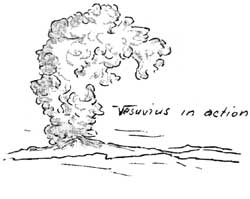
 | ||||||||
Of course no one ever has, but if it were possible to see a cross section of a volcano in action one would no doubt be able to observe many interesting things. As it is we must, of necessity, depend largely upon our powers of deduction in the understanding of the causes of volcanic action by observing the results of such action upon the surface. Ranger-Naturalists, in the regular illustrated lectures during the summer, tell park visitors that at one time this region was not possessed of its great mountain. It was then a rather rough, mountainous region but these mountains were neither very imposing nor very great in size. They were the results of the eroding actions of the elements upon the land that, in the dim, distant past, swelled up from beneath the surface of the sea. But from somewhere deep within the earth's interior, following along lines of weakness or pushing upward through cracks in the crust was rising a column of lava - molten rock. Gases were present too and the entire mass was compresed into a small space by the slowly yielding material which enclosed it. Through pressure and chemical action the molten lavas forced their way upward until there came a time when they could no longer be contained within the earth. Then, in a rush of explosive activity they burst through the surface, throwing rocks and molten material into the air. After the explosive activity dies down with the relief of pressure one may conceive of a more quiet flow of lava flowing out over the land like thick molasses and gradually cooling and hardening to form the first layer of the mountain's base. Even this flow slowly lessens its efforts until it, too, stops entirely - the lavas hardening, as they cool, into rock and plugging the vent by which they sought escape. 
But immediately as this happens the pressure within again begins to increase. Slowly but surely lavas, deep within the earth, which did not cool, again begin pushing their way upward, until again the pressure is too great to be contained and again there is explosive activity. And so, slowly but surely layer upon layer of molten lavas; one after another of explosive eruptions, the mountain gradually takes form -- a gradually tapering cone that characterizes volcanic peaks. As it mounts higher into the heavens the forces of destruction are at work, even as those which built the mountain are carrying on their work. The elements take their toll, chiseling away at the great volcanic pile by means of snow, ice, wind, rain and others in the repertoire of disintegration until the mountain is carved to its present configuration. Steam and gases still issue from fissures about the crater rim of our mountain -- so the forces which constructed it are not yet stilled. And as we hike the trails the silence of the wilderness is punctuated by the thunder of avalanches or the rattle of falling boulders -- proof that the forces of destruction are ever persistent in their activities. - - - - - oOo - - - - -
| ||||||
| <<< Previous | > Cover < | Next >>> |
vol9-12c.htm
12-Jun-2001